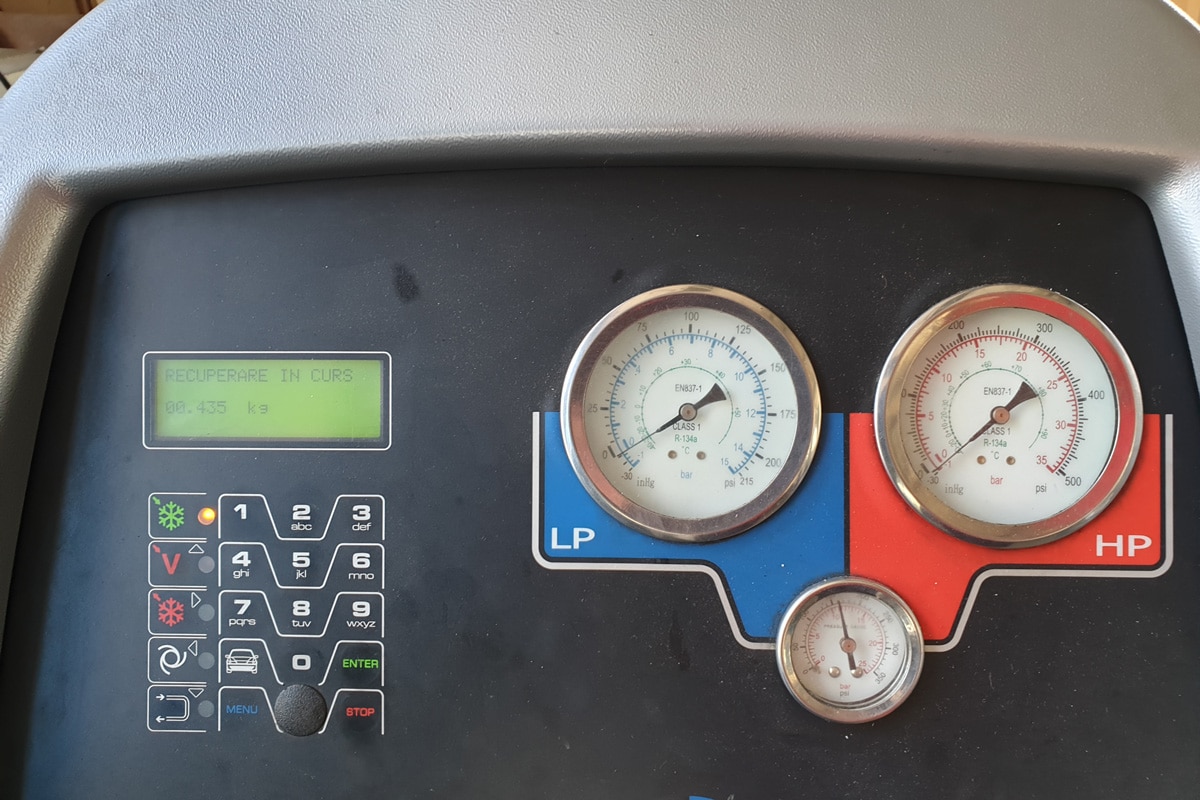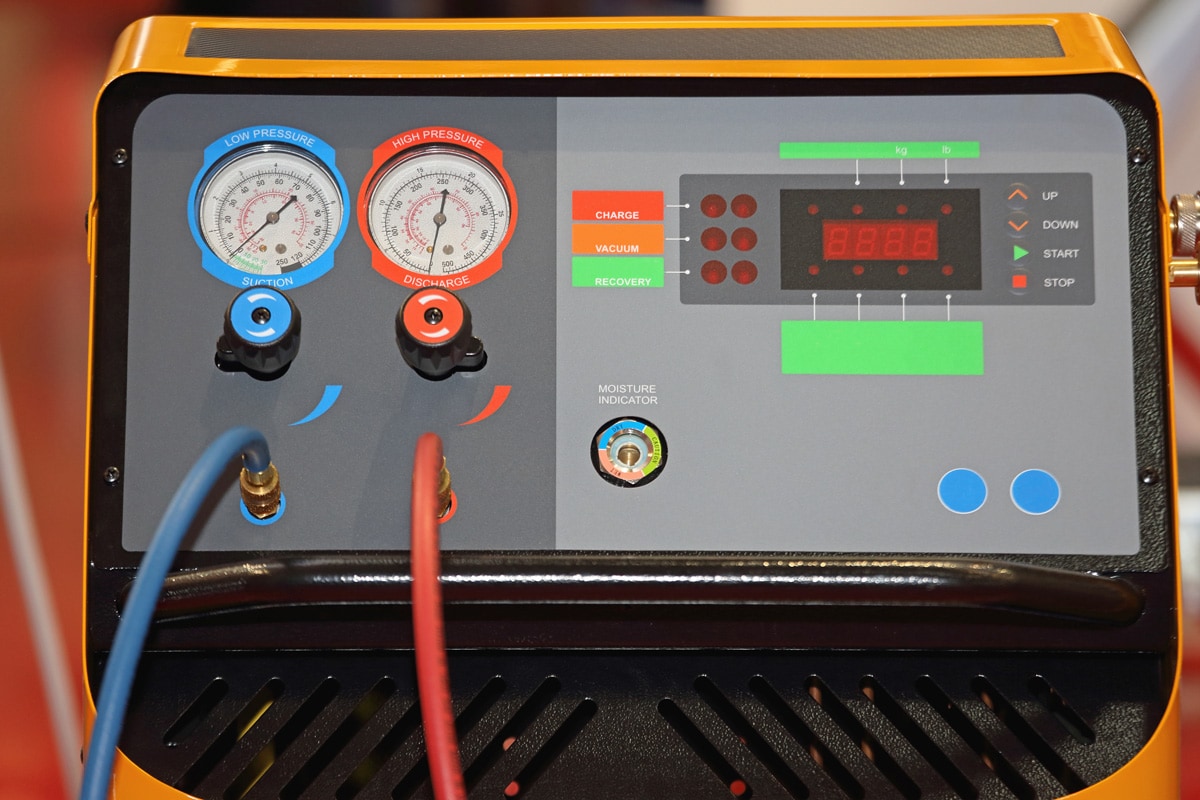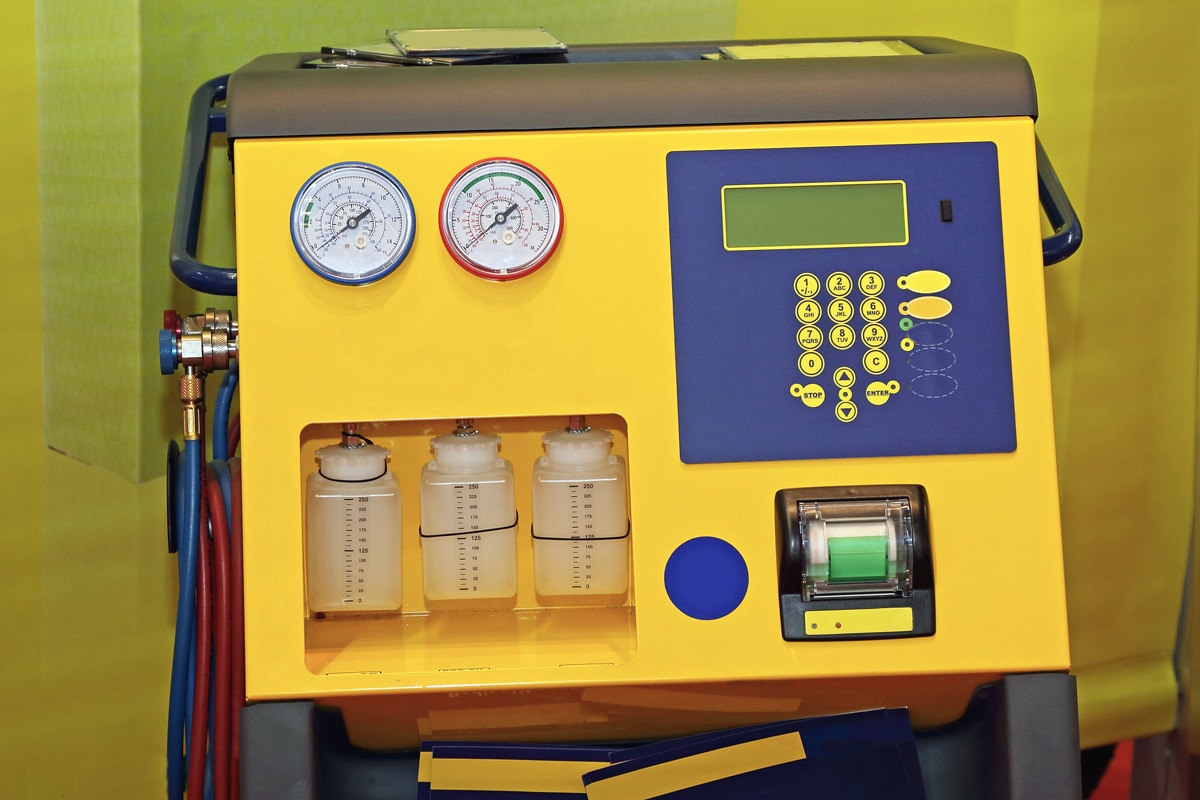Refrigerant recovery from an HVAC system is a practice that has been done for years since you cannot discharge refrigerant into the environment. Have you ever wondered how to operate a recovery machine? If so, keep reading. In this post, we will share the information we have gathered about using a recovery machine.
Learning how to use a recovery machine is quite simple. Just follow these steps:
- Connect the hoses.
- Weigh your recovery tank.
- Unscrew the valve.
- Start the recovery system.
- Begin the purge cycle.
Keep reading as we will discuss each step in greater detail. We will also talk about how the recovery machine works and whether you can reuse the refrigerant you recover. Additionally, we will discuss recycling and regeneration.
![Air conditioning unit placed outside a house, How To Use A Recovery Machine For HVAC [Complete Guide With Detailed Instructions]](https://hvacseer.com/wp-content/uploads/2022/11/How-To-Use-A-Recovery-Machine-For-HVAC-Complete-Guide-With-Detailed-Instructions-1.png)
How To Use A Recovery Machine
Refrigerant recovery is a typical job done by a service expert when servicing or fixing an HVAC system. You can do this task yourself if you are aware of the various recovery techniques.
Furthermore, when you follow the right refrigerant recovery ">processes, you'll avoid damaging the equipment or accidentally harming yourself.
Step 1: Connect The Hoses
Make sure you correctly connect the high side and the low side of the equipment from where the refrigerant should be recovered. Turn off the gauges and the HVAC system you are servicing.
If you're unsure about the high and low sides, here's a helpful hint: a red hose leads to the high side and a blue hose leads to the low side.
The suction line of the recovery machine is connected to the yellow hose. You won't have any problems because the line will be designated as "IN."
Step 2: Weigh Your Recovery Tank
One hose should be connected between the recovery tank and the recovery machine.
Place your recovery tank on a scale before you begin recovering the refrigerant and record the weight so you can track how much is being extracted from the system.
Avoid overfilling the recovery tank. The laws of today prohibit filling your recovery tank to a level greater than 80%.
Step 3: Unscrew The Valve
The air in the hoses can be removed by opening the proper valves from the device to the refrigerant recovery machine. Continue to connect the valve that connects the tank to the refrigerant recovery unit.
Turn the valve slightly to the left until you hear air escaping from the tank side of the connection.
The aforementioned action should only be performed for a brief period before the valve needs to be tightened again. By doing this, the air will completely escape while the refrigerant remains under pressure.
Step 4: Start The Recovery System
After reconnecting each valve, start the refrigerant recovery device. As the refrigerant is drawn into the machine, you will notice a pressure drop.
As soon as the recovery machine's low side pressure reaches 0 psi, keep the machine running.
Step 5: Begin The Purge Cycle
The device will turn off when the pressure drops to 0 psi. The recovery unit should then be set to "purge" by turning both the red and blue valves. You can check if this step was done correctly by looking at the gauges.
The low side will go from high to low, and once it is finished, the machine will shut itself off. After shutting down, close every valve, notably the one leading to the tank for recovering refrigerant.
What Is A Recovery Machine?
The equipment used to remove refrigerant from an HVAC system is referred to as a refrigerant recovery machine.
HVAC systems often have leaks, and these leaks need to be repaired. When this happens, the system's refrigerant must be drained.

The refrigerant cannot be discharged into the environment since doing so would result in contamination and cause harm to the ozone layer.
Consequently, the recovery machine—a device for recovering and storing refrigerant from systems—was created.
How Does The Recovery Machine Work?
A recovery machine that is connected to an air conditioning system's manifold or valves creates a vacuum, then suctions all the freon out of the system before cleaning it with a filter and storing it in a storage tank.
After the system has been repaired, a vacuum will be used to remove all moisture and air from the system by sucking it down the mercury. The presence of air prevents the insertion of freon into closed systems.
Matter and air cannot coexist in the same space at the same time since there is no method to do so.
The technician will program the machine to fill the vehicle with the exact charge of freon after the system has been cleared of air and moisture and the correct amount of charge has been determined for the system's size.
Leaks can also be found with the equipment.
Can You Reuse The Refrigerant You Recover?
It is possible to reuse the refrigerant, but you must exercise caution because the coolant may be polluted by air, combined with another coolant, or with nitrogen.
It may contain acids, water, or particles produced during the combustion of an engine. If a recovered refrigerant is not verified as be clean, it should not be reused in the same system or another system.
What Are Refrigerant Recovery, Recycling, And Regeneration?
Everything leads toward recovering refrigerants in containers so that we won't dispose of them when doing maintenance or repairs or deciding whether to reuse them.
It is best to replace them with a different refrigerant, so keep them stored inside their containers. In this case, learning about refrigerant recovery, recycling, and regeneration can be helpful.
Refrigerant Recovery
Refrigerant recovery is the process of taking the refrigerant fluid out of a fresh or old air conditioning or refrigeration system and storing it in a metal container outside the system without further processing or analysis.
The refrigerant recovery process is a crucial step that must be taken to adhere to the rules governing the substitution of HFCs, CFCs, and HCFCs with new refrigerants and guarantee that our atmosphere is uncontaminated.

Recuperators can extract refrigerant in the form of liquid or vapor, and many of them are also capable of removing a significant amount of the oil that is mixed in with the refrigerant.
After being stored in the recovery cylinder, a decision will be made on the refrigerant's status.
When performing repairs and maintenance on any equipment, be mindful of the significance of avoiding the direct atmospheric release of refrigerant fluids.
After recovery, a decision must be made regarding whether the item is to be reused, treated, or stored in its container.
Click here to see this recovery system on Amazon.
Refrigerant Recycling
Recycling is the process of cleaning the refrigerant so you can use it again.
The refrigerant must be processed once or more through dehydrating filters found in cartridges or specialized desiccant blocks because they can reduce any impurities, moisture, or acidity that may be present.
This is necessary because the refrigerant may have been mixed with pollutants. Typically, recycling is carried out in facilities that specialize in it.
Recycling greatly decreases pollutants by separating oil and other contaminants, but it cannot ensure or guarantee that the refrigerant will be returned to its original purity standards as specified by the manufacturer.
Refrigerant Regeneration
The regeneration process includes the phases of filtering, drying, distillation, and chemical treatment.
The recovered refrigerants must be transported and maintained in standardized bottles before being chemically analyzed by regeneration facilities to determine whether they can regenerate or not.
The quality control that is applied to refrigerant regeneration and recycling operations makes a difference.

Recycling is unrelated to any method that has a current treatment certificate, but it does involve the fundamental removal of oil and other contaminants.
Regeneration, on the other hand, entails the expert cleaning of oil and other contaminants, assuring that the regenerated refrigerants are the same as the originals.
The regenerated refrigerants are delivered by the regeneration centers in their containers, which are properly labeled and have their corresponding certificates.
Summing Up
![Air conditioning unit placed outside a house, How To Use A Recovery Machine For HVAC [Complete Guide With Detailed Instructions]](https://hvacseer.com/wp-content/uploads/2022/11/Air-conditioning-unit-placed-outside-a-house.jpg)
If there is still refrigerant in an HVAC system, a recovery machine must be used. You can complete the task quickly and expertly if you know how to operate the machine.
Remember that you should not combine refrigerants. If you must reuse them, be sure they are crystal-clear and free of contaminants.
If you found this post helpful, check out these related posts:
How To Check Refrigerant Charge Without Gauges?
How To Check & Recharge Mini Split Freon [Step By Step Guide]

